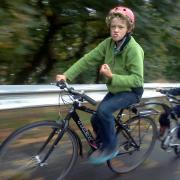 We travel just over two miles to school each day with our two boys - by bike, of course, most days. I am proud that my ten-year old son is now riding his six-year old brother to school on a tag-along! Both boys insist on it now. This picture shows the Big Guy showing off his tough guy face on a recent school trip. Now this system wouldn't work for every ten-year old, but he is very tall for his age, he is Mom's height now, and has been riding (and racing) since he was three. They grow up fast, sigh…
We travel just over two miles to school each day with our two boys - by bike, of course, most days. I am proud that my ten-year old son is now riding his six-year old brother to school on a tag-along! Both boys insist on it now. This picture shows the Big Guy showing off his tough guy face on a recent school trip. Now this system wouldn't work for every ten-year old, but he is very tall for his age, he is Mom's height now, and has been riding (and racing) since he was three. They grow up fast, sigh…
Bicycling to school has helped to make my kids independent, strong and fit.
Walking and bicycling to school does even more. Since it increases physical activity, it helps to reduce the prevalence of childhood obesity, which ultimately leads to adults who are healthier, miss less work days, who are less of a drain on the medical system, who are more likely to live in areas where they can continue their childhood habits of walking and bicycling, which in turn reduces congestion, crashes and air pollution, and promotes smart growth, which is a more effective economic model. You get the picture.
The health of our kids, communities and even our economy is improved through Safe Routes to School. Health is a Calling Card for Safe Routes to School, and economics should also be.
Some corporations are getting this connection. Nike just launched an advocacy campaign called Designed to Move, that addresses health and physical inactivity. Yes, Safe Routes to School is mentioned as one of their solutions! Kaiser Permanente is a funder of our regional network project, and does much more. Blue Cross/Blue Shield and Humana are also doing great prevention work, among others.
Public health practitioners are critical to making Health a Calling Card to Safe Routes to School, as our recent report, co-authored with the American Public Health Association, illustrates: Promoting Active Transportation: An Opportunity for Public Health.
Health champions are becoming strong partners for Safe Routes to School at federal, state and local levels. Learn more in our upcoming webinar, Thursday, November 1: Health Is a Calling Card: Tools to Build Health Into Safe Routes to School. The webinar will highlight how to involve health champions in your programs, how to include health in all policies related to Safe Routes to School, and case studies about how health champions and Safe Routes to School advocates are working together to get kids more physically active and improve our communities.
For more about making Economics a Calling Card for Safe Routes to School, check out our webinar entitled The Economic Benefits of Safe Routes to School (originally aired August 9, 2012). And check out our Library of Resources section on Economic Benefits. Safe Routes to School is a great ROI! (Return on Investment)
Now if I can only get my boys to understand the health and economic benefits of doing their chores and homework and eating vegetables!


